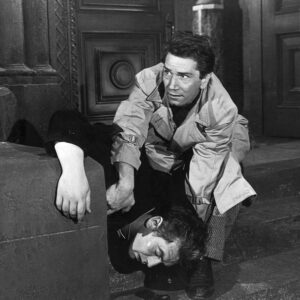This year’s tributes are dedicated to two actors who rose to fame in the mid-1940s and remained at the top until the end of the following decade. Jane Russell (1921–2011) became a Hollywood sex symbol after producer Howard Hughes cast her in the controversial western The Outlaw (1943). The film and its scandalous promotional campaign emphasized the actress’s scantily clad body, and it was precisely her physicality, provocativeness, and sensuality that became key ingredients of her star image for years to come. Russell’s most iconic film was the 1953 Twentieth Century-Fox comedy musical Gentlemen Prefer Blondes, in which she appeared alongside Marilyn Monroe.
However, she maintained a long-term relationship with her mentor Howard Hughes and his company RKO. It was during their collaboration that the film noir His Kind of Woman (1951) was made, which we will be screening at this year’s festival. In the film, directed by John Farrow, the actress’s partner was the well-known film noir icon Robert Mitchum.
Richard Conte (1910–1975) made his film debut in 1939, but in the following years he preferred a career in theater. After a brief stint in the army, he signed a contract with Twentieth Century-Fox, which struggled for a while to find the best use for him. It was not until the second half of the 1940s that his star image began to consolidate successfully in crime films. Conte appeared in quick succession in Somewhere in the Night (1946), 13 Rue Madeleine (1947), Call Northside 777 (1948), Thieves’ Highway, House of Strangers (both 1949) and The Sleeping City (1950).

One of the highlights of this prolific period is undoubtedly Cry of the City (1948), which will commemorate the actor’s legacy this year (and which also serves as a fitting link to the Robert Siodmak retrospective). As the son of Italian-American parents from New Jersey, Conte mostly appeared in roles with Italian origins.As the son of Italian-American parents from New Jersey, he mostly appeared in roles with Italian origins. However, he also demonstrated surprising versatility and was equally convincing as a sadistic gangster (The Big Combo /1955/), a slimy manipulator (Whirlpool /1949/), an innocent victim (Call Northside 777) or a hard-working underdog (Thieves’ Highway). After the production of film noir declined in the 1950s (one of Conte’s last triumphs was The Brothers Rico in 1957), the actor moved into supporting roles and television, but he managed to make a stylish return in 1972 as Don Barzini in The Godfather. Unfortunately, his comeback was short-lived: three years later, at the age of 65, he died of a heart attack.

